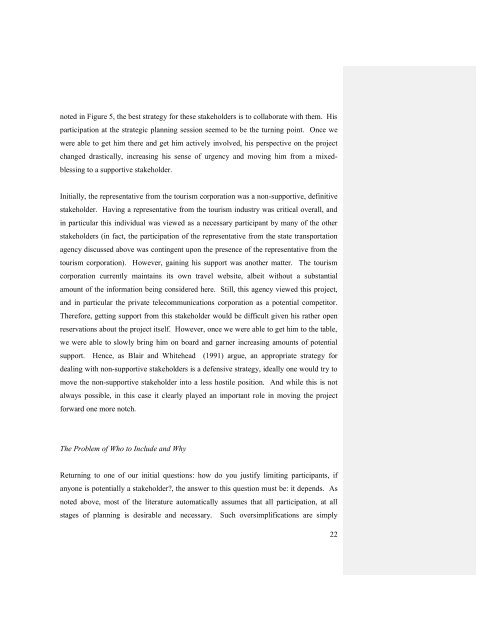The Problem
The Problem
The Problem
You also want an ePaper? Increase the reach of your titles
YUMPU automatically turns print PDFs into web optimized ePapers that Google loves.
noted in Figure 5, the best strategy for these stakeholders is to collaborate with them. His<br />
participation at the strategic planning session seemed to be the turning point. Once we<br />
were able to get him there and get him actively involved, his perspective on the project<br />
changed drastically, increasing his sense of urgency and moving him from a mixedblessing<br />
to a supportive stakeholder.<br />
Initially, the representative from the tourism corporation was a non-supportive, definitive<br />
stakeholder. Having a representative from the tourism industry was critical overall, and<br />
in particular this individual was viewed as a necessary participant by many of the other<br />
stakeholders (in fact, the participation of the representative from the state transportation<br />
agency discussed above was contingent upon the presence of the representative from the<br />
tourism corporation). However, gaining his support was another matter. <strong>The</strong> tourism<br />
corporation currently maintains its own travel website, albeit without a substantial<br />
amount of the information being considered here. Still, this agency viewed this project,<br />
and in particular the private telecommunications corporation as a potential competitor.<br />
<strong>The</strong>refore, getting support from this stakeholder would be difficult given his rather open<br />
reservations about the project itself. However, once we were able to get him to the table,<br />
we were able to slowly bring him on board and garner increasing amounts of potential<br />
support. Hence, as Blair and Whitehead (1991) argue, an appropriate strategy for<br />
dealing with non-supportive stakeholders is a defensive strategy, ideally one would try to<br />
move the non-supportive stakeholder into a less hostile position. And while this is not<br />
always possible, in this case it clearly played an important role in moving the project<br />
forward one more notch.<br />
<strong>The</strong> <strong>Problem</strong> of Who to Include and Why<br />
Returning to one of our initial questions: how do you justify limiting participants, if<br />
anyone is potentially a stakeholder?, the answer to this question must be: it depends. As<br />
noted above, most of the literature automatically assumes that all participation, at all<br />
stages of planning is desirable and necessary. Such oversimplifications are simply<br />
22
















